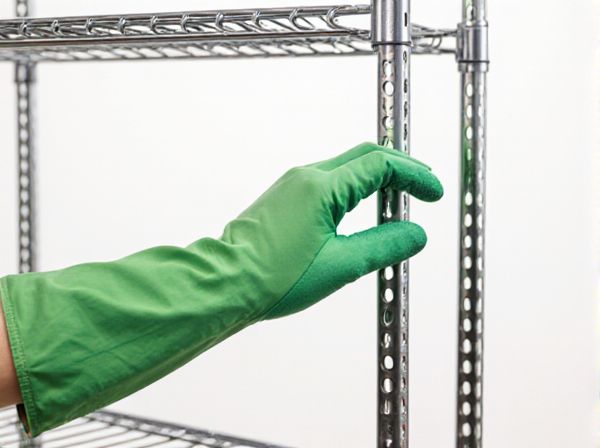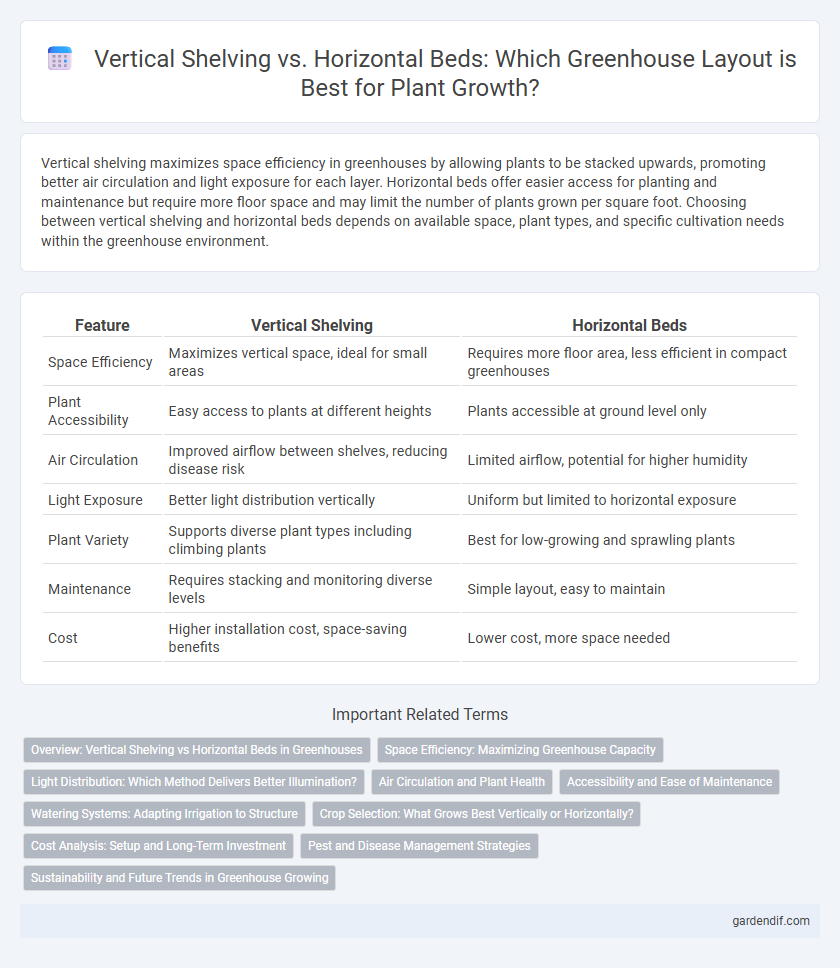
Vertical Shelving vs Horizontal Beds Illustration
Vertical shelving maximizes space efficiency in greenhouses by allowing plants to be stacked upwards, promoting better air circulation and light exposure for each layer. Horizontal beds offer easier access for planting and maintenance but require more floor space and may limit the number of plants grown per square foot. Choosing between vertical shelving and horizontal beds depends on available space, plant types, and specific cultivation needs within the greenhouse environment.
Table of Comparison
| Feature | Vertical Shelving | Horizontal Beds |
|---|---|---|
| Space Efficiency | Maximizes vertical space, ideal for small areas | Requires more floor area, less efficient in compact greenhouses |
| Plant Accessibility | Easy access to plants at different heights | Plants accessible at ground level only |
| Air Circulation | Improved airflow between shelves, reducing disease risk | Limited airflow, potential for higher humidity |
| Light Exposure | Better light distribution vertically | Uniform but limited to horizontal exposure |
| Plant Variety | Supports diverse plant types including climbing plants | Best for low-growing and sprawling plants |
| Maintenance | Requires stacking and monitoring diverse levels | Simple layout, easy to maintain |
| Cost | Higher installation cost, space-saving benefits | Lower cost, more space needed |
Overview: Vertical Shelving vs Horizontal Beds in Greenhouses
Vertical shelving maximizes space utilization in greenhouses by stacking plants upward, allowing for higher density cultivation and improved air circulation. Horizontal beds provide easier access and uniform exposure to natural light but require more floor area, limiting the number of plants grown per square meter. Choosing between vertical shelving and horizontal beds depends on crop type, space availability, and desired yield efficiency within greenhouse environments.
Space Efficiency: Maximizing Greenhouse Capacity
Vertical shelving in greenhouses maximizes space efficiency by utilizing upward growth areas, allowing for higher crop density and better air circulation compared to traditional horizontal beds. This vertical arrangement optimizes light exposure and reduces the footprint required for planting, effectively increasing the number of plants cultivated per square meter. By contrast, horizontal beds require more floor space and can limit overall greenhouse capacity, making vertical shelving ideal for maximizing production in limited areas.
Light Distribution: Which Method Delivers Better Illumination?
Vertical shelving in greenhouses offers superior light distribution by allowing plants to receive more uniform exposure from natural or artificial light sources, minimizing shadowing and maximizing photosynthesis efficiency. Horizontal beds tend to create overlapping canopies that block light to lower foliage, reducing overall illumination and growth potential. Research shows vertical arrangements can increase light capture by up to 30%, optimizing plant health and yield.
Air Circulation and Plant Health
Vertical shelving in greenhouses enhances air circulation by allowing better airflow between plants compared to horizontal beds, which can trap humidity and increase the risk of fungal diseases. Improved ventilation reduces the incidence of mold, mildew, and pests, promoting healthier plant growth. Optimizing space with vertical setups also ensures each plant receives adequate light and fresh air, crucial factors for robust development and yield.
Accessibility and Ease of Maintenance
Vertical shelving in greenhouses maximizes space efficiency by allowing easy access to plants at various heights, reducing bending and stretching. Horizontal beds provide a more uniform layout but often require more physical effort for maintenance due to limited reach and potential soil compaction. Optimizing for accessibility, vertical systems improve workflow and plant care, while horizontal setups favor traditional gardening practices with straightforward irrigation and soil management.
Watering Systems: Adapting Irrigation to Structure
Vertical shelving systems in greenhouses demand precise drip irrigation to target each vertical layer effectively, reducing water waste and promoting uniform moisture distribution. Horizontal beds facilitate traditional overhead or furrow watering methods, which can be simpler but risk uneven water application and runoff. Tailoring the watering system to the structure enhances plant health and resource efficiency by matching irrigation techniques to spatial configurations.
Crop Selection: What Grows Best Vertically or Horizontally?
Leafy greens like lettuce, spinach, and herbs thrive in vertical shelving due to efficient space use and improved air circulation, which reduces disease risk. Root vegetables and sprawling crops such as tomatoes, peppers, and cucumbers perform better in horizontal beds that provide ample soil depth and horizontal spread for sprawling growth. Vertical systems maximize light exposure for compact plants, while horizontal beds accommodate larger, bushier crops requiring extensive root zones.
Cost Analysis: Setup and Long-Term Investment
Vertical shelving in greenhouses offers a higher initial setup cost due to structural materials and specialized installation but maximizes space efficiency, leading to greater crop yield per square foot and potentially higher long-term returns. Horizontal beds require lower upfront investment with simpler construction but occupy more floor space, limiting scalability and increasing maintenance costs over time. Evaluating cost-effectiveness depends on crop type, available greenhouse area, and projected growth, with vertical systems often favored for commercial operations seeking optimized land use and profitability.
Pest and Disease Management Strategies
Vertical shelving in greenhouses enhances air circulation and light penetration, significantly reducing the risk of fungal diseases and pest infestations. Horizontal beds often retain moisture and limit airflow, creating a favorable environment for pathogens like powdery mildew and aphids to thrive. Implementing vertical systems allows for easier monitoring and quicker removal of affected plants, improving overall pest and disease management efficiency.
Sustainability and Future Trends in Greenhouse Growing
Vertical shelving in greenhouses maximizes space efficiency and reduces resource consumption by enabling multi-layered plant growth, leading to lower water usage and higher yield per square foot. Horizontal beds often require more soil and water, while vertical systems support sustainable practices through improved airflow and easier pest management, aligning with future trends in precision agriculture. Emerging technologies in vertical farming, such as automated nutrient delivery and LED lighting, further enhance sustainability and productivity in greenhouse environments.
Vertical Shelving vs Horizontal Beds Infographic

 gardendif.com
gardendif.com